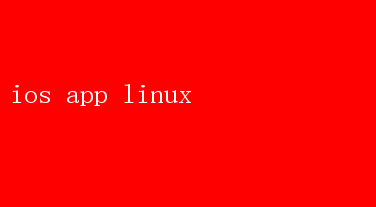
iOS App Development on Linux: A Bold Leap Forward in Cross-Platform Innovation
In the ever-evolving landscape of mobile app development, the boundaries between operating systems are becoming increasingly blurred. While iOS and Android have traditionally dominated the mobile market with their distinct ecosystems and development toolchains, the advent of cross-platform development frameworks has opened new doors for developers. Among these frameworks, the ability to develop iOS applications on Linux has emerged as a particularly intriguing prospect, challenging traditional paradigms and offering a range of compelling benefits.
The Traditional Paradigm: iOS Development on macOS
Historically, developing iOS applications has been a macOS-centric endeavor. Apple’s Xcode, the Integrated Development Environment(IDE) of choice for iOS developers, is exclusively available on macOS. This requirement has long been a sticking point for developers who prefer the flexibility and customization options of Linux, a powerful and versatile operating system favored by many for its open-source nature, stability, and robust security features.
Xcodes tight integration with macOS, combined with Apples stringent control over its development tools and ecosystem, has created a highly optimized but closed environment. This has worked well for Apple, fostering a seamless and streamlined development experience for its loyal developers. However, it has also excluded a significant portion of the developer community that prefers or relies on Linux for their daily work.
The Call for Cross-Platform Solutions
As mobile app development has matured, the demand for cross-platform solutions has grown louder. Developers want to build apps that can reach the broadest possible audience without being tethered to a single platform or toolset. This desire has led to the rise of frameworks like Flutter, React Native, and even more traditional tools like Cordova and Xamarin, which enable developers to write code that can be compiled and run on both iOS and Android.
Despite these advancements, the ability to natively develop iOS apps on Linux remained a distant dream—until recently. The introduction of new tools and technologies has begun to bridge this gap, allowing developers to harness the power of Linux while still targeting iOS devices.
The Rise of Open Source Alternatives
One of the most significant breakthroughs in this domain is the development of open-source tools and services designed to facilitate iOS app development on Linux. These tools leverage the power of cloud-based services, containerization, and virtual machines to emulate the macOS environment necessary for Xcode to function.
1. Using Docker for Xcode Emulation:
Docker, the containerization platform, has played a pivotal role in enabling this shift. By creating Docker containers that emulate a macOS environment, developers can run Xcode within a Linux system. While this approach is not perfect—Docker containers on Linux cannot fully replicate the hardware acceleration and other low-level features of a native macOS install—it provides a viable starting point for many development tasks.
Services like Docker forMac (which, ironically, runs on macOS but can be remotely accessed from Linuxmachines) and custom Docker images configured with Xcode and its dependencies have emerged to cater to this need. While performance might not match a native macOS setup, these solutions offer enough functionality for developers to write, test, and even debug their iOS applications from within Linux.
2. Cloud-Based Development Environments:
Another game-changer is the rise of cloud-based development environments. Platforms like GitHub Codespaces, Gitpod, and even specialized services like MacinCloud offer developers the ability to spin up a virtual macOS machine in the cloud. These environments come pre-installed with Xcode and all necessary tools, allowing developers to access a full-fledged iOS development setup from any device with an internet connection.
The beauty of cloud-based solutions lies in their flexibility and scalability. Developers can choose the specifications of their virtual machine, scale resources up or down as needed, and even collaborate in real-time with team members. These environments often integrate seamlessly with existing development workflows, including version control systems like Git, CI/CD
